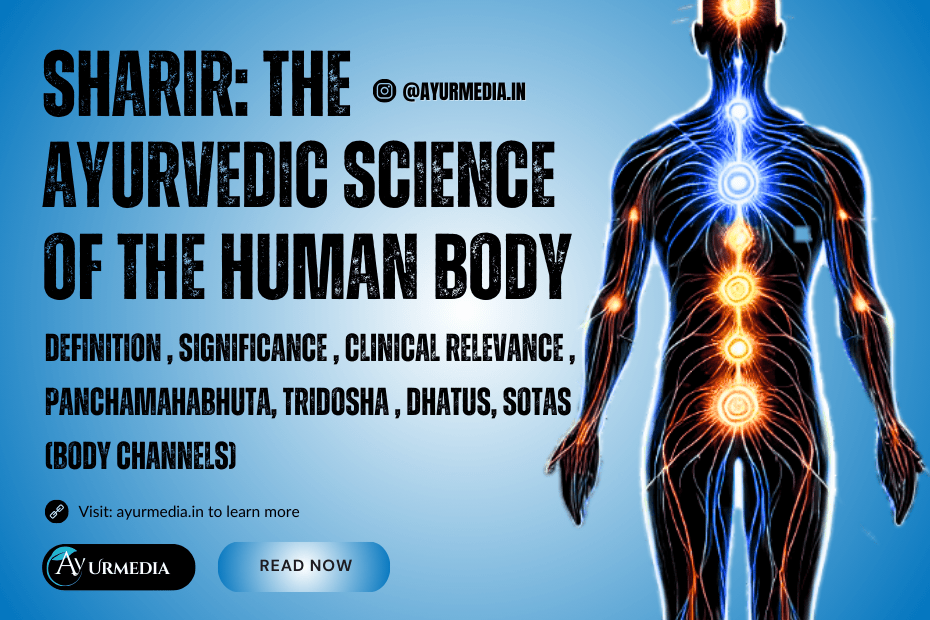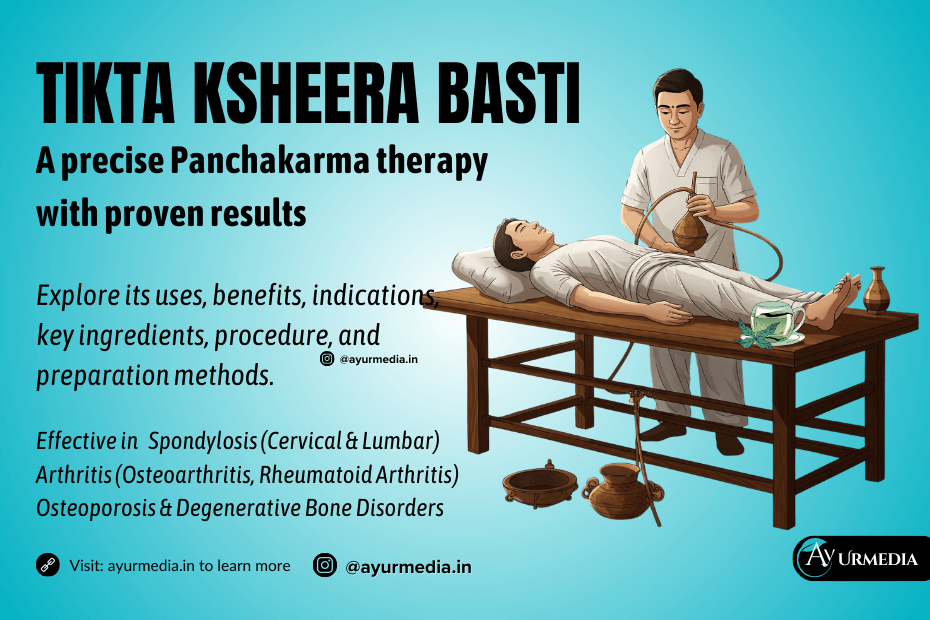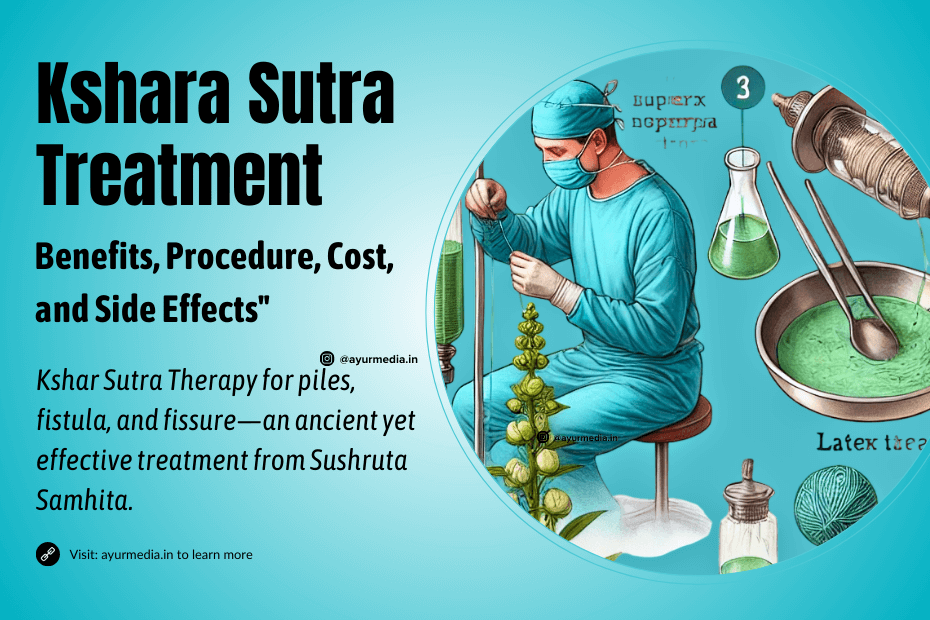Introduction to Sharir
The anatomy of the human body (Sharir) and its relation to the body parts have been the subject of deep study in Ayurveda since ancient times.
Ayurveda views the human body (Sharir) as more than just physical. It is a complex system made up of physical, mental, and spiritual components.
Sharir means the Sharir Shastra or Rachna Sharir, which is the study of anatomy and physiology. It describes the physical body and how it connects with the mind, consciousness (Chetna), and the outside world.1Madhukar, D. L. S. (2022). Review Study on Concept of Sharir in Ayurveda. International Journal for Research in Applied Science and Engineering Technology, 10(7), 4840–4845. https://doi.org/10.22214/ijraset.2022.46051
It is described under Shaarir Sthana (anatomical and physiological science) by various acharyas.
Among them, Sushruta Shaarira Sthana stands out. It is highly valued for its contributions to anatomy.
It includes clear descriptions of the body, the purpose of anatomy, body systems, dissection, surgery, and parasurgical techniques like Kshara Sutra treatment.
It shows how the body’s parts, both structural and functional, work together to keep us healthy.
If the body’s components don’t work together in harmony, the person will suffer poor health.
Anatomy (Rachna Shaarir) and physiology (Kriya Shaarir) are the foundations of Sharir in Ayurveda.
They are further divided into primary branches.
- Rachana Sharir – The study of the structure of the human body (human Anatomy).
- Kriya Sharir – The study of the functional aspects of the body (human Physiology).
Rachna Shaarir (Anatomy)
Rachana Sharir, or Sharir Rachna Vigyan, is a branch of Ayurveda that focuses on the study of structural (anatomical) features of the human body. It is essentially taught in the BAMS curriculum under the subject Rachana Sharir Vigyan.
It is very important to understand Ayurvedic anatomy and physiology for accurate diagnosis and treatment. Because body health depends on the balance or imbalance of its elements.
Let us explore the deeper meaning and Ayurvedic understanding of sharir (the human body).
Etymology and Definition of Sharir
The word Sharir (शरीर) originates from the Sanskrit root “शॄ” (Shru) Dhatu, which means “to decay” or “to wear away.” This reflects the transient and perishable nature of the human body, which continuously undergoes growth, transformation, and eventual decay.
In Ayurveda, Sharir is defined as the inevitable process of change and decay that occurs in the body over time.
The human body is constantly changing; cells break down and regenerate, tissues are repaired, and ageing is a continuous process.
The natural cycle of growth and decay is considered an essential part of life by Ayurveda
Definition of Sharir according to Charaka
- शीर्यते हिनस्ति आत्मानं।
shiryate hinasti atmanam. Ch. Su 8/40
The deterioration (Shiryate) and damage (Hinasti) occurring within oneself (Atmanam) is called Sharir (the body).
The body (Sharir) has an impermanent nature. It undergoes decay. Factors such as poor diet, unhealthy lifestyle, stress, and environmental factors can accelerate this process, leading to the deterioration of bodily functions and health.
According to Ayurveda, the body is maintained by keeping the Doshas (Vata, Pitta, Kapha), Dhatus (Tissues), and Malas (Waste Products) in balance. When this balance is disturbed, the body begins to harm itself through disease and ageing (Hinasti Atmanam).
To prevent natural decay and enjoy good health, it is necessary to preserve the equilibrium of the Doshas, Dhatus, and Malas with the help of appropriate diet, lifestyle, and therapies. Someone who follows this can live healthier.
2. शीर्यते अनेन इति शरीरम्।
Shiryate anena iti shariram. Ch. Su. 1 Chakrapani commentary.
The term Sharir refers to that which undergoes decay, deterioration, or wear and tear.
Think of your body. It looks solid, but in reality, it is always flowing and transforming. Cells regenerate, food turns into energy, and every breath renews life. This verse reminds us that we are not fixed entities but evolving beings.
This verse suggests that the human body is inherently prone to decay and deterioration. The word Shiryate (शीर्यते) implies the process of degradation.
It states that the physical body, in its essence, is transient and is subject to wear and tear, disease, ageing, and eventual death.
This understanding forms the basis of Ayurvedic treatment, which focuses on maintaining the balance between doshas and Dhatus to delay or reduce this natural deterioration.
The verse describes the human body’s impermanence. It is subject to continuous change due to ageing, metabolism, and environmental influences, making it inherently fragile and perishable.
Ayurveda recognises this natural cycle of growth and decay as an essential part of life.
3. तत्र शरीरं नाम चेतनाधिष्ठानभूतं पञ्चमहाभूतविकारसमुदायात्मकं समयोगवाहि।।
(Charaka Samhita, Sharira Sthana 6/3)
The body is the dwelling place of consciousness (Chetna Sthana), formed from the five great elements (Panchamahabhuta). Their transformations constantly shape it, which serves as a vessel for their dynamic union.
Meaning and Explanation
This verse discusses how the body (Sharir) functions as a seat of consciousness (Chetana). According to the verses, the body is formed from the transformation and a combination of the five elements (Panchamahabhuta): Prithvi (Earth), Jala (Water), Agni (Fire), Vayu (Air), and Akasha (Ether).
The body also serves as the abode of consciousness (Chetana Adhishthana), in which the soul resides and expresses itself. It acts as a vehicle carrying the union of these five elements in its physical form.
Definition of Sharir according to Sushrut
According to Sushruta Samhita, Sharir is composed of Doshas (Vata, Pitta, and Kapha), Dhatus (tissues), and Malas (waste products), which together form the functional and structural basis of the human body.
- दोष धातु मल मूलं हि शरीरम्।। Sushruta Sutrasthana, 15/2.
“dosha dhatu mala mulam hi shariram”
Meaning: The body is rooted in the balance of doshas, tissues, and waste products.”
This verse explains that the physical body is a manifestation of Tridoshas (three bodily humours), Sapta Dhatu (7 basic tissues), and Malas (three basic waste products). This applies to the living body, all of these are made from the five elements (Panchamahabhuta).
2. शुक्रशोणितं गर्भाशयस्थ आत्मप्रकृतिविकार संमूर्छितं गर्भ इत्युच्यते | तं चेतनावस्थितं वायुविर्भजति, तेज एनं पचति, आपः क्लेदयन्ति, पृथिवी संहन्ति, आकाशं विवर्धयति, एवं विवर्धितः स यदा हस्तपादजिव्हाघ्राणकर्णनितम्बादिभिर्अङ्गेरूपेतस्तदा शरीरं इति संज्ञा लभते |
Charaka Samhita, Sharira Sthana 5/3.
Translation: The sperm and ovum, when united in the womb, are transformed by the nature of the soul and called the embryo (Garbha). When the embryo is in a state of consciousness, it is influenced by five elements: air (Vayu) gives it movement, fire (Teja) digests, water (Jala) moistens, earth (Prithvi) solidifies, and ether (Akasha) gives it space.
As the embryo grows, it takes the shape of a body, complete with hands, feet, tongues, noses, ears, and buttocks. It is now referred to as the body (Sharir).
Meaning and Explanation
This Shloka describes the process of embryonic development in Ayurveda, beginning with the fertilisation process and the union of the sperm (Shukra) and ovum (Shonita). It describes how the five elements (Mahabhuta) combine with the growing soul to make the body.
It also outlines how the various elements contribute to the development of different bodily functions and features.
When the product of fertilisation (Garbha) is actively energetic:
- Vayu initiated division and movement.
- Agni regulates metabolism.
- Jala ensures adequate hydration and nourishment.
- Prithvi provides structural stability.
- Akasha creates a space for developing the body.
Once the sensory and motor organs develop, they become a fully recognisable human body (Sharira).
Definition of Sharir by Vagbhata
“शीयते रोगादीनां यत तत शरीर”
(Ashtanga Hridaya, Sutra Sthana 1/3)
Sharir undergoes wear and tear due to diseases and the ageing process.
Synonyms of Sharir
Ayurveda uses various terms to describe the body, each highlighting a specific aspect of the human body.
- Sharir (Shiryate Anena Iti Shariram) – That which undergoes decay and disintegration.
- Deha (Dih Upachaye – दिह उपचये।) – That which continuously undergoes nourishment and growth.
- Kaya (Chiyate Annadibhihi – चीयते अन्नादिभिः।) – That which is maintained and replenished by food and digestion.
- Purusha (Puri Vasati Iti Purusha – पुरि वसति इति पुरुषः।) – Purusha is expressed as the dwelling of the soul (Chetna Adhishthana).
- Tanu: Tanu” is identified as “Tanoti Vistarayati Kulam” indicating that which expands and spreads within the body.
Types of Sharir
According to Ayurveda, the human body is classified into two primary types depending on its nature and function.
1. Sthula Sharir (Gross Body)
It represents the physical body formed by the action of Panchamahabhutas. It includes all the body parts, tissues, organs, systems, and structures that can be visually seen and sensed. This body is nourished through food and water and undergoes constant changes due to ageing and metabolism.
2. Sukshma Sharir (Subtle Body)
Refers to the nonphysical aspects of the body, which consists of the mind, intellect, and spirit. It is responsible for thoughts, emotions, spiritual energy, and consciousness. It is connected to the gross body via the Pranas( life forces) and is responsible for Chetana (consciousness).
Formation of Sharir
According to Ayurveda, Sharir is formed during embryonic development through the following combination:
- Shukra (Sperm) and Shonita (Ovum)
- Atma (Soul) – Consciousness
- Panchamahabhuta (Five Elements) – Structural foundation
- Karma (past deeds), determines the genetic and spiritual blueprint.
- Tridosha, which serves as a guide for body development, is sustained by proper nourishment (Ahara), lifestyle (Vihara), and mental balance (Sattva).
Shadanga Sharir or The Six Parts of the Body
Acharya Sushruta has divided the human body into six major components. These components are essential to the human anatomy.
These include the upper and lower limbs, the Madhya Sharir trunk (thorax + belly), and the head, which is the uppermost part of the body.
- Dakshina Urdhva Shakha (Right upper extremity)
- Vaama Urdhva Shakha (Right lower extremity)
- Dakshin Adha Shakha (Left upper extremity)
- Vama Adha Shakha (Left lower extremity)
- Madhya Sharir, Trunk (thorax + abdomen)
- Shir (The Head and neck)
These six divisions provide a structural understanding of Sharir.
Components of Sharir in Ayurveda and Role of Doshas, Dhatus, and Malas
Ayurvedic understanding of the human body is based on a holistic framework that includes the following components:
Panchamahabhuta (Five Elements)
According to Ayurveda, the body is made up of five fundamental elements that form the structural and functional basis of all living beings.
- Prithvi (Earth): This represents solidity, stability, structure, and anabolism, manifesting in bones, muscles, and tissues. It is linked to the sense of smell or Gandha Guna.
- Apas/Jala (Water): Indicates fluidity and cohesiveness present in bodily fluids, such as plasma and cytoplasm. It is associated with a sense of taste or Rasa Guna.
- Tejas/Agni (fire): Responsible for the regulation of digestion processes and enzymatic actions through metabolism, transformation, and absorption. It is associated with Roop Guna (complexion).
- Vayu (Air): Vayu is associated with dryness, movement, and regulation, which aids in functions such as respiration, circulation, and nerve impulses. It is associated with Sparsha Guna (sense of touch).
- Akasha (Ether/Space): It is considered the first element of Panchamahabhuta. other elements are believed to emerge from it. It represents the softness and emptiness. It is associated with sound and the sense of hearing (Shabda Guna), expansion, and communication (cellular space, channels).
These elements combine in various proportions to form body structures and functions.
Tridosha (Three Humours)
The three basic bioenergetic forces, known as Doshas, regulate the functional integrity of the body. These are critical for maintaining health, and their imbalance can lead to disease.
- Vata: Composed of Vayu (air) and Akasha (emptiness), it regulates movement, nerve impulses, and elimination processes. It is considered superior among Tridosha because it influences the movement of the Pitta and Kapha doshas. It is considered Prana (life), which is sustained by the proper balance of the Vata.
- Pitta: Formed from Tejas (fire) and a small amount of Jala (water). It regulates digestion, metabolism, and body temperature.
- Kapha: It consists of Prithvi and Jala (water), and provides structural integrity, lubrication, and strength.
The balance of these doshas is critical for overall health because imbalance leads to disease.
Sapta Dhatu (Seven Tissues)
रसात् रक्तं ततः मांसं मांसान्मेदस्ततोऽस्थि।”
Charaka Samhita, Sutra Sthana 28/4
Rasa Dhatu gives rise to Rakta Dhatu (blood cells), which gives rise to Mamsa, and so on.
The nourishment and structural integrity of the body are maintained through Sapta Dhatu (seven primary tissues), each of which is sequentially nourished by the previous tissue, highlighting an intricate metabolic pathway.
- Rasa (plasma/lymph): The primary tissue that is responsible for transporting nutrients and maintaining hydration.
- Rakta (blood): It is responsible for oxygenation and vital functions.
- Mamsa (muscle): Provides form and facilitates movement.
- Meda (fat/adipose tissue): It offers lubrication and energy storage.
- Asthi (bone): It gives structural support and protection.
- Majja Dhatu (Bone Marrow): It is responsible for filling bone cavities and providing support to the nervous system.
- Shukra (Reproductive Tissue): It is considered the essence of all Dhatu and a collection of reproductive elements that are essential for reproduction.
Srotas (Channels)
The proper functioning of the body relies on the unobstructed flow of nutrients and waste products via a network of channels known as Srotasa. These channels facilitate the movement of various substances within the body. Any blockage or damage to these Srotasa (channels) can lead to disease.
For example, Pranavaha Srotas holds a vital life force (Prana) and is associated with the respiratory system. Annavaha Srotas carries nutrients and is linked to the digestive tract, whereas Rasavaha Srotas carries Rasa Dhatu and is related to the circulatory system.
Waste Products (Malas)
Three major excretory products (trimalas) are essential for maintaining bodily balance.
- Purisha (faeces): Eliminating waste from digestion.
- Mutra (Urine): Eliminates liquid metabolic waste.
- Sveda (sweat): Regulates body temperature and expels toxins.
The proper elimination of malas (waste products) plays a crucial role in maintaining physiological balance.
Soul (Atma) and Mind (Manas)
Ayurveda views the body as a temporary vessel for the soul (atma). Achieving mental balance (manas) is important for maintaining physical health.
Dashavidha Pariksha: The Tenfold Examination in Ayurveda
In Charaka Samhita Vimana Sthana 8/94, ten fundamental methods are described for examining the body. These methods help evaluate health, diagnose diseases, and guide treatments.
- Prakriti Pariksha – This involves the evaluation of an individual’s natural body constitution (Vata, Pitta, and Kapha) to understand inherent strengths and weaknesses.
- Vikriti Pariksha – Assessment of current disease pathology by identifying Dosha imbalances and underlying disturbances.
- Sara Pariksha – Examination of the quality and strength of body tissues (Dhatus), which reflect overall health and resilience.
- Samhanana Pariksha – Analysis of the body’s structural integrity, indicating physical strength and stability.
- Pramana Pariksha – Measurement of body proportions and physical dimensions to evaluate structural balance.
- Satmya Pariksha – Involves finding individual compatibility with specific foods, habits, and environmental factors.
- Sattva Pariksha – Assessment of mental strength, emotional stability, and psychological resilience.
- Ahara Pariksha – Analysing dietary habits, digestive efficiency, and nutritional status.
- Vyayama Pariksha – Assessment of physical strength, stamina, and capacity for physical activity.
- Vaya Pariksha – Evaluation of age and life stage to tailor treatments according to the individual’s developmental phase.
Significance of Sharir in Ayurveda
Understanding the body is essential for accurate Ayurvedic diagnosis and treatment. The natural functions of the body depend on the balance of Trioshas, proper nutrition of the seven Dhatus, proper elimination of wastes and unrestricted flow of Srotasa.
When any of these elements get aggravated, it can lead to illness. This aggravation can be managed by proper diet (aahar), lifestyle (vihaara) and seasonal adaptations (ritucharya).
Pathology of Sharir
Ayurveda defines disease as a disturbance in the natural state of Tridosha.
- Vikriti – Imbalance of Doshas.
- Srotorodha – Blockage of channels.
- Dhatu Kshaya – depletion of tissues.
- Ama formation – Accumulation of toxins due to improper digestion.
An imbalance in any of these components leads to dysfunction and manifestation of the disease. Ayurvedic diagnosis focuses on identifying which of these components is disturbed to target the root cause of the disease.
Clinical Application and Relevance of Rachana Sharir
Rachana Sharir (Anatomy) helps in understanding the structural organisation of the body, while Kriya Sharir (Physiology) provides insight into the functional aspects of Doshas, Dhatus, and Malas.
The Ayurvedic physician assesses the Prakriti (the body’s constitution), Doshas imbalance, Dhatus depletion, digestive power and the functioning of Srotas to determine the underlying cause of the disease.
To examine the condition of the body (Sharir), Ayurveda uses Dashavidha Pariksha (a tenfold diagnostic framework). The Ayurvedic treatment aims to restore the balance between these components, as follows:
- Panchakarma (detoxification): Cleans bodily channels.
- Shamana (Palliative Treatment): To balance the Doshas through diet and medication.
- Shodhana (purification): To eliminate the accumulated toxins.
Conclusion
According to Ayurveda, the Sharir (body) is much more than an anatomical structure. Instead, it is a dynamic system that is ever-changing and regulated by Panchamahabhuta, Tridosha, Sapta Dhatu, and Srotasa. Your bodies differ from one day to the next. Cells are being shed, tissues are growing and the normal cycle of ageing is progressing.
Ayurveda uses Sharir (body) as a diagnostic tool, and the Ayurvedic treatment seeks to restore balance to this constantly changing system with appropriate food, lifestyle and therapeutic interventions. Balance is when there is the absence of disease and is the reflection of harmony with nature.
This is a principle within traditional and modern health care. The Ayurvedic insight of the Sharir (body) offers different dimensions of diagnosis and treatment. It is the core principle of the practice of Ayurveda. The Sharir Sthana, a part of the Sushruta Samhita, provides an authentic explanation of the structure (Anatomy) and function (physiology) of the human body.
References
- 1Madhukar, D. L. S. (2022). Review Study on Concept of Sharir in Ayurveda. International Journal for Research in Applied Science and Engineering Technology, 10(7), 4840–4845. https://doi.org/10.22214/ijraset.2022.46051



